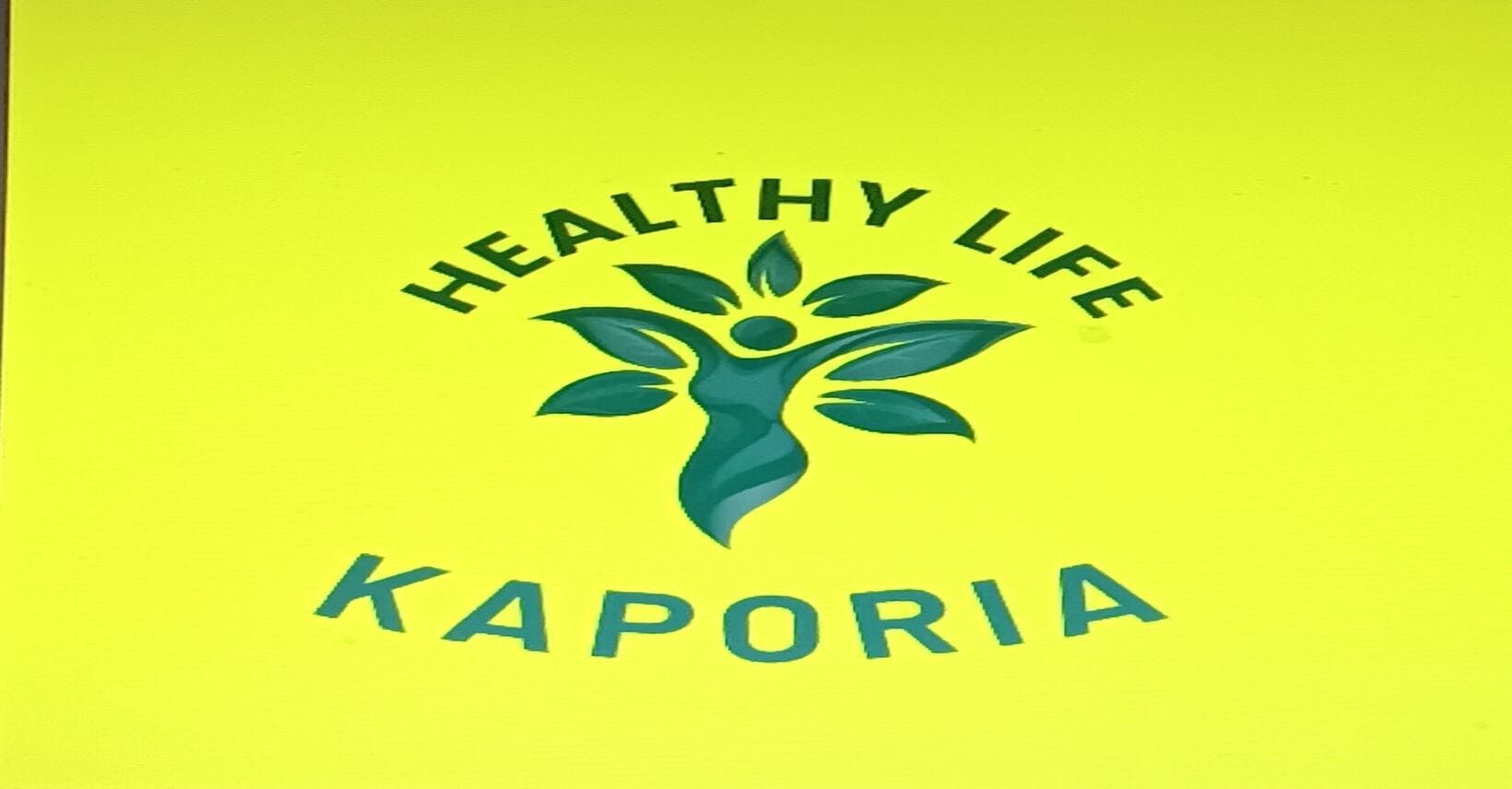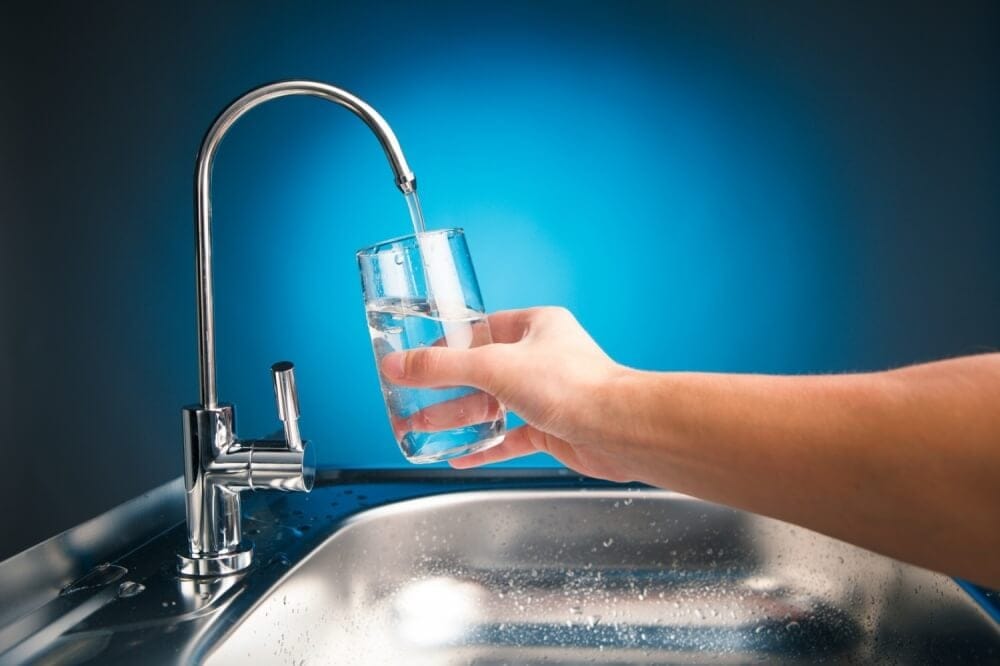[ad_1]
In the USA, faucet water is probably the most examined and controlled supply of water you’ll find. That stated, faucet water can nonetheless include chemical compounds you don’t wish to eat, prepare dinner with, or bathe in, like chloramines, fluoride and even hazardous pollution like heavy metals, petrochemicals, pesticides or prescribed drugs.
Right here’s how one can get the most secure, most cost-effective, and most sustainable water on your residence.
The Horrible Reality About Bottled Water
Though many individuals imagine bottled water to be more healthy than faucet water, the reality is, bottled waters will not be topic to just about the identical degree of scrutiny and regulation, and the federal authorities doesn’t mandate that bottled water be any safer than faucet water.
Actually, the chemical pollution standards for bottled water and tap water are nearly identical, and most bottled water manufacturers are simply filtered faucet water anyway. Basically, they’re promoting you the bottle (at 2000% markup), as a result of you possibly can cheaply filter faucet water at residence.
Even worse, whereas most public water utilities are required to reveal their testing outcomes to the general public yearly, bottled water firms will not be required to launch their testing information to the general public in any respect, besides within the state of California, the place a minimal of knowledge is required. So in the event you purchase bottled water, you simply can’t be certain of what you’re getting.
In depth analysis carried out by The Environmental Working Group (EWG) discovered 38 contaminants in 10 popular brands of bottled water, together with disinfection byproducts, industrial chemical compounds, arsenic, fertilizer residue and ache medicine.
The examine additionally included assays for breast most cancers cell proliferation, carried out on the College of Missouri. One bottled water model spurred a 78% improve within the progress of the breast most cancers cells in comparison with the management pattern.
Separate testing carried out by the Pure Sources Protection Council additionally found many contaminants in bottled water. And lots of manufacturers of bottled water have been recalled because of contaminants like E. coli.
It’s clear that confidence within the purity of bottled water is essentially unjustified, and in lots of circumstances the trade could also be delivering a beverage that’s little cleaner than faucet water—however bought at a 2,000 occasions the fee.
Bottled water additionally takes an unlimited toll on the setting. Contemplate these ugly information:
- Yearly, the equivalent of 17 million barrels of oil are used to supply plastic water and soda bottles within the U.S.—not together with transportation. Bottling water produces greater than 2.5 million tons of carbon dioxide per 12 months.
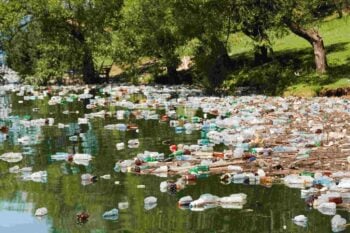
 In accordance with Peter Gleick of the Pacific Institute, solely a few third of all bottles of water consumed in the USA are recycled, which means that about two-thirds find yourself within the rubbish—or as litter.
In accordance with Peter Gleick of the Pacific Institute, solely a few third of all bottles of water consumed in the USA are recycled, which means that about two-thirds find yourself within the rubbish—or as litter.- Even the minority of bottles that do get recycled are merely down-cycled. In different phrases, after another incarnation, they are going to find yourself within the landfill (or as litter) anyway.
- Subsequent to plastic luggage, plastic bottles are probably the most prevalent supply of air pollution discovered on our seashores and shores. Annually, over 500 billion disposable bottles and cups find yourself littering our soil, rivers, lakes and oceans, killing numerous fish and animals. (See picture to the suitable.)
- According to the Pacific Institute, it takes 3 liters of water to supply 1 liter of bottled water.
- When you add within the water wanted to fabricate paper labels and transportation gasoline, it really takes nearer to SIX bottles of water to produce 1 liter of bottled water.
- From creation to disposal, plastic water bottles contribute to air air pollution. And lots of the chemical compounds that go into their manufacturing proceed to leach out into the air, and from the bottle into the water they maintain.
Given the contemporary water shortages and droughts occurring within the U.S. and worldwide, the quantity of plastic bottle waste polluting our land and oceans, plus the extent of bronchial asthma, most cancers and different illnesses associated to the oil and chemical compounds used to make plastic water bottles, all for one thing that will get used for about an hour—this degree of waste and air pollution is unconscionable.
That is why you should absolutely give up bottled water for good.
Associated
Why Do You Have to Filter Faucet Water?
Though bottled water isn’t any cleaner or safer than faucet water, irrespective of the place you reside, your faucet water is bound to include some chemical compounds you don’t wish to drink, prepare dinner with or take in into your pores and skin whereas bathing or washing your arms. That’s as a result of the chemical air pollution requirements for faucet water and bottled water are comparatively lax, and solely cowl the pollution and microorganisms which can be recognized to make you instantly sick.
At a minimal, all municipal faucet water incorporates chlorine to kill micro organism. Many cities additionally add fluoride to the water, believing it helps with dental well being. (It doesn’t, and can cause harm.)
Over the previous few years, most water districts have began including chloramines (chlorine+ammonia) to our water. This dramatically modifications the panorama of water filtration and purification as a result of not like chlorine, chloramines are very arduous to take away, and so they leach metals like copper and lead out of your pipes into your water!
The American Journal of Public Well being linked chlorine to “vital will increase in sure sorts of most cancers, bronchial asthma and pores and skin irritations” and decided that “as much as two-thirds of the dangerous publicity was because of pores and skin absorption and inhalation of chlorine in bathe water.”
Actually, research has proven that your physique can take in extra dangerous disinfectant byproducts from a 10-minute bathe than ingesting one liter (one quart) of faucet water.
However chlorine, chloramines and fluoride will not be the one stuff you might need to fret about.
For instance, the Environmental Working Group spent three years analyzing the outcomes of just about 20 million ingesting water assessments from water utilities. The excellent news is that their assessments present that native water suppliers meet Environmental Safety Company necessary water high quality requirements 92 p.c of the time.
The dangerous information is that they detected 316 pollution general in water provided to numerous cities within the U.S. since 2004. Greater than half of the pollution they discovered are utterly unregulated (like pharmaceutical residues and radioactive particles), and greater than 130 turned up in quantities exceeding official health-based tips.
As an example, each single faucet water supply they checked was polluted with undesirable chemical compounds referred to as trihalomethanes. Trihalomethanes are Risky Natural Chemical compounds (VOCs) that type when chlorine, a disinfectant added to the water to kill harmful micro organism, reacts with rotting natural matter akin to runoff from farms, sewage and even useless leaves and bugs.
Trihalomethanes are nearly unattainable to forestall in municipal water methods, and are linked to bladder most cancers, reproductive issues, and different severe diseases. One member of this household is chloroform, which the U.S. authorities considers a possible human carcinogen.
The Environmental Safety Company regulates this chemical household, however EWG believes that lots of EPA’s rules—that are based mostly on a compromise between well being danger and prices—must be a lot harder to guard kids and pregnant ladies, particularly.
Since VOCs like trihalomethanes will be inhaled or absorbed by means of the pores and skin, in addition to ingested, you undoubtedly wish to get them out of your cooking and bathing water.
If you’re on nicely water, don’t suppose you might be resistant to contamination in your faucet water. It’s necessary to have your water examined commonly as a result of wells will be simply polluted by radon, radioactive particles, extreme ranges of naturally occurring fluoride or arsenic, animal manure, pesticides and intensely poisonous fracking chemical compounds.
Between ingesting, cooking, washing dishes, watering vegetable gardens, brushing tooth and bathing, we will be uncovered to much more waterborne toxins than we understand, and authorities rules simply aren’t tight sufficient to guard our well being over the long run.
This is the reason, even in the event you purchase bottled water (Please, don’t.), you continue to should filter your faucet water.
How one can Discover Out What’s in Your Water
Environmental Working Group’s Faucet Water Database contains details about ingesting water high quality for practically 50,000 neighborhood water methods nationwide. EWG’s database features a whole of practically 31 million take a look at outcomes for 534 chemical compounds, 324 of which had been detected in ingesting water, making it the most important useful resource of free and overtly accessible information on U.S. ingesting water.
You can look up the results of the EWG survey for your city here.
You can too discover out extra about what’s in your faucet water by checking the water high quality report revealed yearly by your water utility. This is a crucial useful resource that buyers usually overlook. It’s normally referred to as a “Shopper Confidence Report,” however may additionally be titled “Water High quality Report,” or “Consuming Water High quality.”
The regulation requires that the utility present this report back to all its clients by July 1 of every 12 months. It’s best to have obtained one within the mail. Should you by chance threw it out, you possibly can request one, or you could discover a digital copy on the utility’s web site.
How one can Learn a Water High quality Report
Water contaminants and concentrations detected by the water utility are sometimes offered in a desk. Listed below are some phrases you’ll see:
- Components per billion (ppb) or elements per million (ppm) – These are measurements of the focus of a chemical.
- Most Contaminant Stage (MCL) – That is the authorized most set by federal regulation and EPA rules. Pay shut consideration to readings increased than the Most Contaminant Stage, or MCL. These violate federal regulation and rules.
- Most Contaminant Stage Objective (MCLG) – It is a voluntary preferrred degree set by public well being consultants to reduce dangers. Most of EPA’s authorized limits are usually increased than the corresponding targets as a result of rules should take into consideration value and feasibility.
- Motion Stage (AL) – If the focus of a chemical exceeds this quantity, a water provider should conduct further remedy or take different measures.
Take a very cautious take a look at the measurements for arsenic, lead, chromium-6, and trihalomethanes. Even when they don’t exceed the regulatory cap, they are often linked to severe well being issues, even in “allowable” dosages.
As soon as you recognize what pollution are in your water, you possibly can finest determine what sort of filter you will have to take away them. A superb filter won’t solely pay for itself over time, however, not like bottles of water, it would additionally give you loads of clear water for cooking and bathing, too.
Testing Faucet Water at House
Your water utility’s Water High quality Report can inform you numerous about what’s in your faucet water because it’s leaving the power. However what it will probably’t let you know is what pollutes your water because it travels by means of the pipes in your city and your own home. This is the reason residence testing will be helpful.
House faucet water testing kits can take a look at your water for the most typical pollution and micro organism, in addition to hardness and pH. If you’re on nicely water, or fear about heavy metals like lead or copper in your water pipes, a house testing package can let you know what is actually popping out of your faucet, and show you how to select the suitable water filter to unravel the issue.
How one can Select a Water Filter
You’ll be able to decide up a small faucet-mount water filter or filtration pitcher from nearly any huge field retailer, however most had been designed to enhance style, and may solely filter out sediment, chlorine, lead, and maybe a number of different issues.
To take away the arsenic, fluoride, trihalomethanes, prescribed drugs, pesticides and different toxins which can be more likely to be in your faucet water, you will have a a lot better high quality filter. A filtration pitcher or faucet-mount filter (like Pur or Brita) purchased at an enormous field retailer simply received’t do the job.
Before you purchase a filter, all the time examine the product specs completely to make certain it will probably filter out the actual contaminants which can be in your faucet water, in accordance with the report put out by your water utility firm.
You’ll additionally wish to assess how usually you want to change filter cartridges (and have extras readily available), and another upkeep the filter requires to perform optimally. Some water filters require increased upkeep than others.
Bear in mind, a top quality water filter can pay for itself shortly, particularly in the event you sometimes purchase bottled water, so it’s price shopping for the very best quality filter you possibly can afford that may deal with the actual toxins in your faucet water.
Reverse Osmosis (RO) Filters
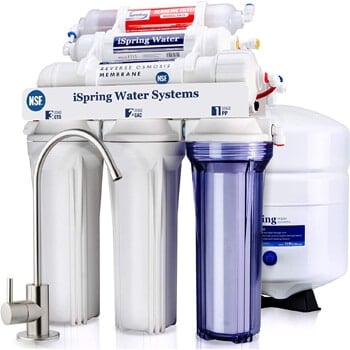

Reverse osmosis water filtration methods is usually a bit dear, however they use a mix of filtration strategies to take away fluoride, arsenic, lead, chlorine, VOCs and practically all different environmental toxins present in municipal faucet water.
Nevertheless they’ll additionally waste plenty of water, and so they can go away water tasting terribly flat, with none helpful mineral ions, like calcium or magnesium.
Customary RO methods will not be the only option if you would like water that tastes crisp and refreshing proper from the faucet, however there are newer methods on the market that add the minerals again in after filtration.
Should you use a normal reverse osmosis system to filter your water that doesn’t have remineralization functionality, be sure you get a product to add to your water to replace the minerals and make it style a lot higher.
Water Distillers
Throughout distillation, water is boiled and evaporated away from its dissolved minerals, after which the vapor is condensed and the ensuing water droplets collected. Because of this whereas distillers will take away micro organism, cysts and heavy metals very nicely, they can’t take away gases like chlorine, VOCs and radon, until they’ve further vents and carbon filters included within the distiller unit.
Distillers additionally take each monitoring to ensure they shut off when completed and don’t overheat, and cautious cleansing/descaling to perform correctly. They produce clear water slowly, and can even vitality be intensive, since most require electrical energy to work.
Distilled water is an energetic absorber, and when it makes contact with air, it shortly absorbs carbon dioxide and turns into acidic. Distilled water can even style flat, so that you would possibly wish to regulate the pH by including the wholesome minerals again in with a product like ConcenTrace.
Aluminum Oxide or Activated Alumina Fluoride Filters
These filters usually require frequent cartridge modifications, however will be fairly fairly priced. Although made with aluminum compounds, they do not contaminate your water with aluminum.
Activated alumina filters sometimes solely take away or cut back fluoride and arsenic, so you have to mix them with a carbon block filter. Collectively an activated alumina filter with a carbon block can filter out chlorine, most fluoride, arsenic, micro organism, VOCs and extra, however can’t sometimes filter out pharmaceutical residues and sure petrochemicals.
At all times examine the specs on these filters to ensure they’ll take away your specific contaminants.
Carbon Block Gravity Filters
Carbon block gravity filters take away pathogenic micro organism, cysts and parasites fully and extract dangerous chemical compounds akin to herbicides, pesticides, VOCs, natural solvents, radon 222 and trihalomethanes. Additionally they cut back nitrates, nitrites and unhealthy minerals akin to lead and mercury, however could not have the ability to take away fluoride and pharmaceutical residues.
You’ll be able to pour scummy pond water right into a carbon block gravity filter and have it come out protected to drink, making it good for tenting and emergencies.
Carbon block gravity filters will not be hooked up to your sink, and the water flows by means of the carbon blocks by gravity alone, to allow them to take a very long time to filter. It’s essential be sure you refill them usually so that you all the time have sufficient clear water readily available for cooking and ingesting.
Big Berkey water filters not solely have non-obligatory added alumina cartridges that cut back fluoride and arsenic, however additionally they come in several sizes, relying in your wants and price range. Here’s where to buy a Big Berkey.
Bathe and Tub Water Filters
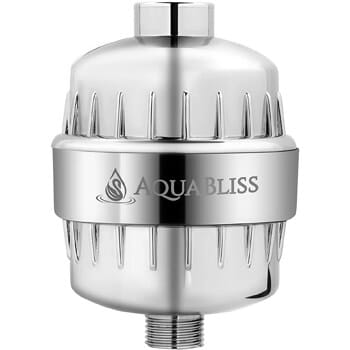

Your pores and skin is a extremely permeable membrane that may simply take in something utilized to it. Bathing day-after-day in faucet water that incorporates chlorine, chloramines, trihalomethanes and different doable toxins exposes you to a degree of those chemical compounds far higher than you may get by ingesting them alone. That is particularly problematic for kids.
This is the reason filtering your bathe and tub water is an excellent concept. As an added bonus, with the chlorine and chloramines filtered out, your pores and skin and hair might be softer, and you’ll alleviate the issues many individuals have with chlorinated bathe water, like pink eyes and dry, itchy or rashy pores and skin.
Should you prefer to take baths, one of the simplest ways to filter your tub water is to get a high-quality bathe filter, after which use the bathe head to fill your bathtub.
Professional Tip: If you wish to take away free chlorine, sediment, metals, VOCs, and chloramines, join each of those filters collectively. You received’t imagine the distinction!
Backyard Water Filters
Don’t neglect about your backyard! The chlorine and different chemical compounds in faucet water can kill all the great micro-organisms in your soil. You’ll be able to forestall this through the use of a BPA- and phthalate-free garden hose, utilizing collected rain water to water your backyard, and filtering your faucet water on the hose spigot.
Entire Home Filters
Should you can afford it, it’s an amazing concept to put in a whole-house filtration system. Entire-house filters connect the place the principle water line comes into your house from the road, so they supply the primary line of filtration protection on your water provide.
Most whole-house filters can’t filter every little thing (you would possibly nonetheless want a filter on the point-of-use to get issues like pharmaceutical residues out), however they’ll present dechlorinated water for every little thing from cooking to bathing to watering the backyard.
As soon as you recognize what contaminants are in your water, putting in the suitable filter to take away them can prevent all the cash you’ll have spent on bottled water, and make an enormous distinction for the well being of your loved ones and the setting!
What Do I Do With My Previous Water Filter Cartridges?
Many water filtrations methods have cartridges or inside filters that must be changed frequently. That is usually yearly, however some as usually as each three months. Examine the label, handbook, or web site on your water filtration system to seek out its alternative cycle.
Some firms will recycle your used filtration cartridges, so examine with the producer of your filter system to see if they’ve a program. Sadly, provided that filters include all of the poisonous contaminants that they’ve prevented you from consuming, spent filters sometimes must be disposed of, even when their plastic housing will be recycled.
Although sometimes not recycled, distillers and reverse osmosis filters are thought of to be extra environmentally-friendly options, as a result of the filter housing is hooked up to the system and is rarely thrown away. The cartridges include considerably much less plastic than faucet filter cartridges, so much less plastic finally ends up being thrown within the trash.
Regardless of this, the environmental and economical footprint of bottled water (even when it’s recycled) remains to be a lot bigger than that of filtered water.
It will be nice if we didn’t have toxins in our water to start with, and subsequently didn’t have to filter it and use all of the cradle to grave assets that go into filtration. However till we lastly get our governments to put money into the cleanest, most secure faucet water, there may be nothing higher for you, your pockets, and the planet than filtered faucet water.
By investing in an excellent water filter, you’ll get monetary savings, drink, prepare dinner and bathe with water that’s purer than faucet water or bottled water, and assist resolve the worldwide glut of plastic bottles.
Up to date December 2, 2021
[ad_2]
Source link
